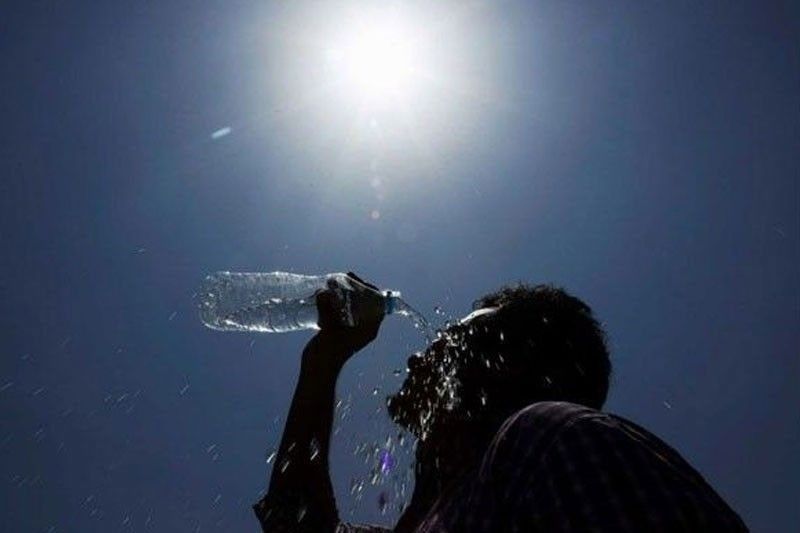Heat | Philippines Weather Turns Deadly As 7 Killed

Don’t let the heat get the best of you. Stay tuned for essential insights and survival tactics to thrive in the heat of the moment.
Table of Contents
Review: Deadly Heatwave Strikes the Philippines
In recent days, the Philippines has been reeling under the impact of an intense and deadly heat, resulting in tragic consequences. Reports indicate that at least 7 individuals have lost their lives due to the extreme weather conditions, highlighting the urgent need for attention to climate-related issues and public health concerns.
Overview of the Situation
The Philippines, known for its tropical climate, is experiencing an unusually severe heatwave. The scorching temperatures have not only disrupted daily life but have also posed significant health risks to vulnerable populations, particularly the elderly and those with pre-existing health conditions.
Impact on Communities
The deadly heatwave has had a devastating impact on communities across the Philippines:
Loss of Life: The reported deaths underscore the severity of the heatwave and its lethal consequences.
Health Implications: Many individuals are suffering from heat-related illnesses such as heatstroke, dehydration, and exhaustion.
Challenges for Agriculture: The extreme heat has also posed challenges for agriculture, affecting crops and livestock.
Response and Preparedness
Local authorities and health organizations are mobilizing efforts to mitigate the effects of the heatwave:
Issuance of Warnings: Public advisories have been issued to raise awareness about the dangers of prolonged exposure to high temperatures.
Distribution of Aid: Efforts are underway to distribute water, provide cooling stations, and offer medical assistance to affected communities.
Calls for Climate Action: The heatwave serves as a stark reminder of the urgent need for climate action to address the impacts of global warming and extreme weather events.
Call for Awareness and Action
The deadly heatwave in the Philippines serves as a wake-up call to prioritize climate resilience and public health measures:
Climate Resilience: Investing in climate-resilient infrastructure and sustainable practices is crucial to mitigate the impact of heatwaves and other climate-related events.
Community Preparedness: Empowering communities with information and resources to cope with extreme weather is essential for saving lives.
Global Collaboration: Addressing climate change requires global collaboration and commitments to reduce greenhouse gas emissions and promote sustainable development.
Conclusion
The tragic deaths and widespread impact of the heatwave in the Philippines underscore the urgent need for proactive measures to address climate-related challenges. It is imperative for governments, organizations, and individuals to prioritize climate resilience, public health, and community preparedness to mitigate the devastating effects of extreme weather events like heatwaves.
Let this unfortunate incident serve as a catalyst for collective action towards building a more sustainable and resilient future for all.
This review aims to shed light on the gravity of the heatwave situation in the Philippines and the critical importance of addressing climate change and its impacts on vulnerable communities.
Heat Index in PH
The index, also known as the “feels-like” temperature, is a measure of how hot it feels when relative humidity is factored in with the actual air temperature. In the Philippines, where the climate is typically warm and humid, the index can often exceed the actual air temperature due to high humidity levels.
During periods of intense heatwaves or hot weather, the index in the Philippines can reach dangerous levels, posing health risks such as exhaustion and heatstroke. It’s important for residents and visitors to be aware of the index and take appropriate precautions to stay safe in extreme conditions.
Here are some general guidelines based on the index levels:
Less than 27°C (80°F): No precautions needed.
27°C to 32°C (80°F to 90°F): Basic precautions such as staying hydrated and avoiding strenuous outdoor activities during peak sun hours.
32°C to 41°C (90°F to 105°F): Heat cramps and heat exhaustion are possible. Avoid prolonged outdoor activities and stay hydrated.
41°C to 54°C (105°F to 130°F): Dangerously high risk of related illnesses like heatstroke. Avoid outdoor activities and seek air-conditioned or shaded areas.
It’s important to monitor weather forecasts and advisories issued by local authorities, especially during periods of extreme weather. Taking preventive measures, such as staying hydrated, wearing light clothing, and seeking shade or air-conditioned spaces, can help mitigate the risks associated with high index conditions in the Philippines.
If you experience symptoms of heat-related illness, such as dizziness, nausea, rapid heartbeat, or confusion, seek medical attention immediately. Related illnesses can be life-threatening and require prompt medical intervention.
Stay informed, stay cool, and prioritize your health and safety during times of elevated heat index in the Philippines.
What to do?
When facing high index conditions, especially in places like the Philippines where the climate can be particularly hot and humid, it’s important to take proactive steps to stay safe and protect your health. Here’s what you can do to cope with and minimize the risks associated with extreme temperature:
1. Stay Hydrated
Drink plenty of water throughout the day, even if you don’t feel thirsty. Avoid excessive consumption of sugary or alcoholic beverages, as they can contribute to dehydration.
2. Limit Outdoor Activities
Minimize outdoor activities, especially during the hottest parts of the day (typically between 10 AM and 4 PM). If you must be outside, try to schedule activities for cooler times, such as early morning or evening.
3. Wear Appropriate Clothing
Dress in lightweight, loose-fitting, and light-colored clothing to help keep your body cool. Wearing a wide-brimmed hat and sunglasses can also provide additional protection from the sun.
4. Seek Shade or Air-Conditioned Spaces
Stay indoors in air-conditioned buildings as much as possible. If you don’t have air conditioning at home, consider visiting public places like shopping malls, libraries, or community centers that have cooling facilities.
5. Use Cooling Measures
Take cool showers or baths to lower your body temperature. Use fans and damp cloths to create a cooling effect. Place ice packs or cool towels on your body to help reduce heat.
6. Protect Vulnerable Individuals
Check on elderly family members, neighbors, and those with chronic illnesses to ensure they are coping with the weather. Provide assistance and support as needed.
7. Avoid Strenuous Activities
Avoid engaging in strenuous physical activities or exercises outdoors, especially in direct sunlight. If you exercise, do so in a well-ventilated and shaded area, and drink plenty of water.
8. Stay Informed
Keep track of weather forecasts and advisories issued by local authorities. Stay informed about index levels and take necessary precautions accordingly.
9. Be Mindful of Heat-Related Illnesses
Learn to recognize the signs and symptoms of heat-related illnesses such as heat exhaustion and heatstroke. Seek medical attention immediately if you or someone else experiences symptoms like dizziness, rapid heartbeat, nausea, or confusion.
10. Plan Ahead
Plan activities and errands to avoid exposure to extreme weather. Take breaks, rest, and prioritize self-care during periods of high temperatures.
By following these guidelines and taking proactive measures, you can protect yourself and your loved ones from the adverse effects of high index conditions. Stay vigilant, stay cool, and prioritize your health and safety during hot weather situations in the Philippines or any other region experiencing extreme temperature.
Disclaimer
The information provided in this conclusion is intended for general guidance and educational purposes only. It is not a substitute for professional medical advice, diagnosis, or treatment.
When coping with high index conditions or extreme weather, it is important to prioritize your health and safety by consulting with healthcare professionals or local authorities for specific recommendations and guidelines tailored to your individual circumstances and location.
While the suggestions provided are based on general recommendations for managing heat-related risks, individual responses to weather can vary, and additional precautions may be necessary depending on personal health factors, environmental conditions, and other considerations.
Always exercise caution and use common sense when dealing with extreme weather conditions. If you or someone else experiences symptoms of related illness, such as dizziness, nausea, confusion, rapid heartbeat, or exhaustion, seek immediate medical attention.
Furthermore, be aware of local weather advisories and follow recommendations from official sources to stay informed about index levels and related health risks.
By staying informed, taking proactive measures, and seeking appropriate guidance, you can better protect yourself and others from the adverse effects of high index conditions in the Philippines or any other region experiencing extreme heat.
Stay safe, stay cool, and prioritize your well-being during hot weather situations.
Conclusion: Coping with High Heat Index in the Philippines
In conclusion, coping with high index conditions in the Philippines requires proactive measures and responsible actions to protect yourself and others from heat-related illnesses. By following these guidelines, you can stay safe and minimize the risks associated with extreme weather:
Stay Hydrated: Drink plenty of water throughout the day to stay hydrated and avoid dehydration.
Limit Outdoor Activities: Minimize outdoor activities during the hottest parts of the day and schedule them for cooler times.
Wear Appropriate Clothing: Dress in lightweight, loose-fitting clothing and wear a hat and sunglasses to shield yourself from the sun.
Seek Shade or Air-Conditioned Spaces: Stay indoors in air-conditioned buildings or seek shaded areas when outdoors.
Use Cooling Measures: Take cool showers, use fans, and apply cool towels to lower body temperature.
Protect Vulnerable Individuals: Check on elderly family members and neighbors, and provide support to those with chronic illnesses.
Avoid Strenuous Activities: Refrain from engaging in strenuous physical activities outdoors, especially in direct sunlight.
Stay Informed: Monitor weather forecasts and advisories issued by local authorities to stay informed about heat index levels.
Be Mindful of Heat-Related Illnesses: Learn to recognize the signs of exhaustion and heatstroke, and seek medical help if necessary.
Plan Ahead: Plan activities and errands to minimize exposure to extreme weather, and prioritize self-care during hot weather.
It’s crucial to take these precautions seriously, especially during periods of intense heatwaves or high index. By staying vigilant and implementing preventive measures, you can mitigate the risks associated with extreme heat and ensure the well-being of yourself and your community.
Remember, staying cool and hydrated is key to staying safe in hot weather conditions. Prioritize your health and take necessary actions to cope with the challenges posed by high index in the Philippines or any other region experiencing similar climate conditions.
Stay informed, stay safe, and take care of yourself and others during hot weather situations.
If you have any more questions or need further assistance, feel free to ask!
ADVERTISEMENT

Jom Bourie a professional poker player and an author of books about poker. Boasts an impressive 37-year tenure in the gambling industry, with a passion for gaming that has earned him a reputation as a trusted and knowledgeable figure. His dedication to precision, integrity, and transparency has enabled him to provide players with unparalleled insights and recommendations for exceptional online gaming experiences.
His videos have been viewed more than 22 million times on YouTube and his casino travel articles have appeared in magazines. He has also written numerous articles for gaming magazines circulation gaming magazines.